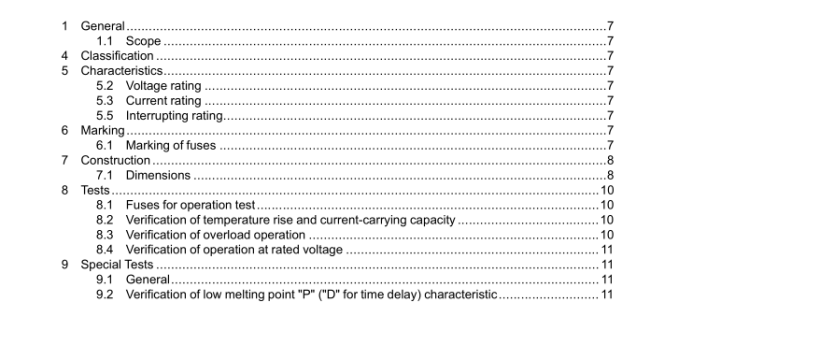UL 248-6 2019 pdf download.Low-Voltage Fuses – Part 6: Class H Non-Renewable Fuses.
1 General NOTE – This Part is intended to be read togetherwith the Standard forLow-Voltage Fuses – Part 1: General Requirements, hereafterreferred to as Part 1. The numbering ofthe Clauses in this Part correspond to like numbered Clauses in Part 1. The requirements ofPart 1 apply unless modified by this Part. For Clauses not shown below, refer to the Standard for Low-Voltage Fuses – Part 1: General Requirements, NMX-J-009/248/6-2000-ANCE ♦ CAN/CSA C22.2 No. 248.1 ♦ UL 248-1. 1.1 Scope This Part applies to Class H Non-Renewable fuses rated 600 A or less and either 250 or 600 V ac. DC ratings are optional. 4 Classification Class H Non-Renewable fuses have an interrupting rating of 10,000 A. Both of the voltage ratings 250 V ac and 600 V ac are divided into six body sizes with the maximum current rating in each size as specified in this Part. These fuses are not classified as current limiting. Time-delay ratings are optional. In Canada, 250 V ac fuses rated 15 – 60 A shall have a low melting point “P” (“D” for time delay) characteristic. See Clauses 6.1 and 9.2. 5 Characteristics 5.2 Voltage rating For AC, the rating shall be 250 V ac or 600 V ac in accordance with dimensions shown in Figure A and Figure B. The DC voltage rating may be different from the AC rating. 5.3 Current rating Refer to Figure A and Figure B for range of current ratings in each body size for each voltage rating. 5.5 Interrupting rating For AC – 10,000 A For DC – 10,000 A 6 Marking 6.1 Marking of fuses In addition to the requirements in Part 1: Fuses with a low melting point characteristic, for Canada, shall be marked with a “P” or with a “D” for time delay. g) The fuse shall not be marked “Current Limiting.”
8.2 Verification of temperature rise and current-carrying capacity 8.2.3 Test method 1.0 I n – Temperature rise 1.1 I n – Current-carrying capacity, I nf 8.2.3.1 Fuses rated 600 A or less In addition to the requirements in Part 1: At the conclusion of the temperature rise test, the test current shall be increased without interruption to 1.1 I n for a period of not less than 15 min for fuses rated 0 – 200 A and not less than 30 min for fuses rated 201 – 600 A. Temperature is not to be monitored during this time. 8.2.4 Acceptability of test results In addition to the requirements in Part 1: The maximum temperature rise shall not exceed the following: Contacts – ≤100 A – 55°C >100 A – 75°C 8.3 Verification of overload operation Part 1, Table 4 Test 1 – 1.35 I n Test 3 – 2 I n Test 5 – 5 I n for time-delay fuses only. For 250 Vac rated 30 A or less, the clearing time shall be 8 s minimum.
8.4 Verification of operation at rated voltage For AC – Part 1, Table 5 Test 4c – 10,000 A, except the power factor is to be 0.85– 0.95 for fuses rated 100 A or less. Test 5b – 2 I n For DC – Part 1, Table 6 Test 1 – High current (10,000 A) Test 5a – 9 I n , for time-delay fuses only Test 5c – 2 I n 9 Special Tests 9.1 General 9.1.1 Types of tests For fuses with a low melting point “P” (“D” for time-delay) characteristic, one fuse of each body size shall be tested. 9.2 Verification of low melting point “P” (“D” for time delay) characteristic 9.2.1 The fuse shall open in an ambient of 200°C maximum when tested as specified in Clauses 9.2.2 and 9.2.3. 9.2.2 The fuse shall be placed in an ambient of 200° C maximum with a test current of 10 percent of rating maximum for a period of 6 h maximum. After the fuse opens it shall be allowed to cool to room temperature 25 ±5°C without being disturbed. 9.2.3 A test voltage shall be applied to the fuse and gradually increased from 0 V until rated voltage is reached or until the current exceeds 5 mA. The fuse shall be considered to have opened if the current between the fuse terminal parts does not exceed 5 mA when rated voltage is applied between such parts.UL 248-6-2019 pdf download.
UL 248-6-2019 pdf download
